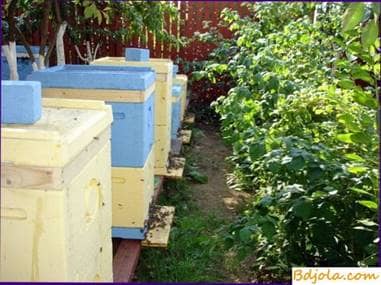
From the correct choice of location for the establishment of a reserve apiary, its welfare and productivity depend. Preference should be given to terrain with a crossed Relief, which contributes to an increase in the total area in the summer’s radius of bees and to an extension of the flowering period of the honey beans.
The hive site should be located in a dry place, be flat, preferably with a slight slope to the south, east or west for precipitation of atmospheric precipitation. Do not put the hives in places with a strong draft of air, in drafts, as well as in pits, where in the morning the fog accumulates. Bees easily tolerate low minus temperatures, but are afraid of wind and moist air. An increase in wind speed of one meter per second for bees is felt as a decrease in air temperature by about 2 њ.
Fog, representing the concentration of cold water droplets in the air, penetrating the hive, takes away a lot of heat. Bees have to spend a lot of energy to maintain the optimal microclimate in the hive. It is noticed that in sheltered, elevated places where fogs are rare, bee colonies first start working outside the hive, grow faster and are more productive.
You can not place an apiary near large rivers and lakes, if on the opposite side there are honey-plants of the native side, ponds reduce the pasture area for bees, on the other – bees returning with a heavy burden die from flying through the pond from wind and fatigue. Separate beekeepers observed the greatest death of bees on a pond in windless weather.
This is explained, apparently, by the fact that in the mirror of the reservoir, especially when there are no waves, the bees see the reflection of trees and, losing their orientation, perish in the water.
It is undesirable to put an apiary near railroads and highways, factories that produce and use sugary products, as well as near chemical factories of children’s institutions, cattle farms, silos and under a high-voltage power line.
In the absence of natural obstacles restraining the gusts of the wind, the apiary should be fenced with a fence and then with a hedge height of at least 2 m. If there are fences, the bees fly high, do not disturb passers-by and are peaceful. Fencing the apiary with a fence, it must be borne in mind that, with a continuous fence, the wind, reaching the barrier, deflects upwards and after a distance equal to 5-6 times the height of the fence blows with the same force. Shrubs and fruit trees planted in the apiary significantly reduce the wind speed, at the same time serve as good reference points for bees and queens, and at noon shadows hive from the sun’s rays. On the side of the paddock site, the production (auxiliary) buildings are placed.
Hives in the apiary are located depending on the size of the area. It is beautiful when the hives are arranged in square or staggered order with a distance between hives of 4-5 m. This method of placing the hives is acceptable on large apiary areas with a sufficient number of plant landmarks and a variety of hives coloring.
With cramped accommodation of the hives and inadequate orientation, the bees wander, which results in the amplification of certain families by weakening others. At marriage departures uteruses are lost, therefore at small size of the apiary area a group arrangement of hives is used. In each group, 2-4 hives are put, having their flaps in different directions, avoiding the northern one. With a group arrangement of hives, bees wander less and less often the uterus is lost.
Beehives are put on pegs, boxes or coasters, set strictly on the level. This is necessary for the correct detuning of the cells. To ensure that no dirt accumulates in the corners of the bottom, and rainwater does not accumulate in the hives, the back of the pillars or stakes is made 1-2 cm above the front. The height of the supports should correspond to the growth of the beekeeper so that it can work without bending.
It’s nice when the apiary is landscaped and landscaped. Regular mowing of grass forms an even green carpet, creating coolness and freshness in hot sunny days.
Walking in the apiary is more convenient behind the hives, but in no case should one make special paths and clean them from the turf, and also sprinkle with sand. This is laborious, and bees, in addition to harm, do not give anything. The work of bees to collect pollen and nectar is often interrupted by short or prolonged rains. Not all bees have time to return to the hive on time. Many of them are strayed by the wind and drops of rain. The fallen bees hide on stems and under the leaves of grasses, and when the sun warms them, they warm up and return to the hive. Bees fall into worse conditions, if there are no vegetation near the hives. The bees fall into the mud, mix with it and perish. An important role in ensuring the safety of bees has unpainted flying boards. From the first rain drops painted boards quickly get wet and bees, knocked down by wind or rain, stick to them with wings and often die.
Дворовый туалет. Смородина с медом.
Hothouse beekeeping